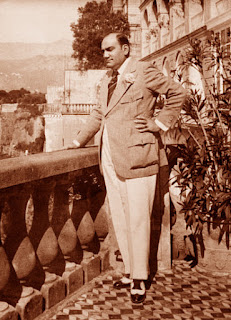 |
| The famous picture of Enrico Caruso on the balcony of the Excelsior Vittoria hotel |
It shows Caruso standing on the terrace of the Grand Hotel Excelsior Vittoria, where he could enjoy the stunning view over the Bay of Naples.
The hotel later furnished Suite Caruso with the piano and writing desk used by the opera singer during his visit. The suite inspired the song 'Caruso’ to be written by Italian pop singer Lucio Dalla in the late 1980s while he was staying at the Excelsior Vittoria.
Believed by many opera experts to be the greatest tenor of all time, Caruso graced many of the most famous opera houses in Europe and America during a brilliant 25-year singing career.
He made more than 200 recordings, some dating back to 1902, and was opera's first international star.
Born in Via San Giovanello agli Ottocalli in Naples and baptised the next day in the nearby church of San Giovanni e Paolo, he was apprenticed to a mechanical engineer at the age of just 11 years and also worked alongside his father in a factory.
But at the same time he was singing in his church choir and was told his voice showed enough promise for him to consider becoming a professional singer.
He was encouraged by his mother until she died in 1888. To earn money, he started to work as a street singer in Naples, progressing to singing Neapolitan songs as entertainment in cafes.
Determined he would become an opera singer, Caruso took singing lessons before, during and after his compulsory military service.
He made his stage debut in 1895 at the Teatro Nuovo in Naples in Domenico Morelli’s L’amico Francesco, having been recommended by a musician who had heard him sing.
 |
| The Basilica of San Francesco di Paola in Naples, where Caruso's funeral took place |
The following year he appeared in Monte Carlo, Warsaw, Buenos Aires and before the Tsar of Russia in St Petersburg.
Caruso took part in a grand concert at La Scala organised by Toscanini in 1901 to mark the death of Giuseppe Verdi. A month later he was engaged to make his first group of recordings for a gramophone company using a hotel room in Milan. The recordings quickly became best sellers and Caruso’s fame spread.
He travelled to New York in 1903 to take up a contract with the Metroplitan Opera, making his debut in Rigoletto in November.
A few months later Caruso began his association with the Victor Talking Machine Company. His 1904 recording of ‘Vesti la giubba’ was the first recording ever to sell a million copies.
He made 863 appearances at the Met, attracting a substantial following from among New York ’s Italian immigrants. He continued to release recordings until close to his death in 1921.
Caruso’s voice extended up to high D-flat in its prime and grew in power and weight as he became older. His singing can still be enjoyed by people today as his original recordings have been remastered and issued as CDs and digital downloads.
The singer’s health began to deteriorate in 1920 and he returned to Naples to recuperate. He was planning to go to a clinic in Rome in August 1921, but while he was staying overnight at the Albergo Vesuvio in Naples on the way to Rome his condition worsened and he died there, aged 48.
The King of Italy, Victor Emmanuel III, opened the Royal Basilica of San Francesco di Paola -- on the west side of the Piazza del Plebiscito in Naples -- for his funeral, which was attended by thousands of people.
 |
| The plaque outside the Grand Hotel Excelsior Vittoria commemorating the life of Enrico Caruso |
In Sorrento, there is a plaque in his name at the main entrance gate to the Grand Hotel Excelsior Vittoria, which is just off Piazza Tasso.
Home